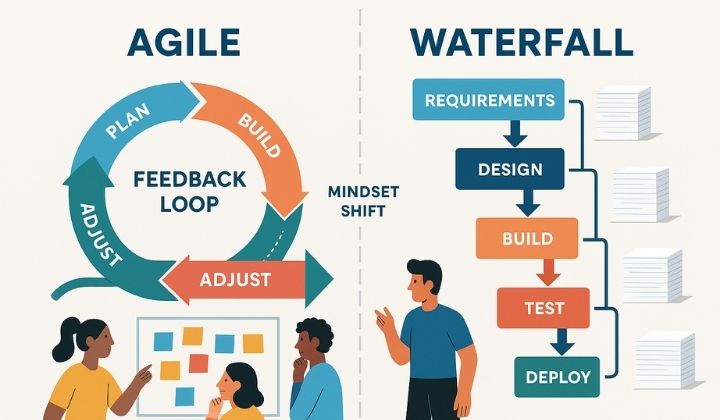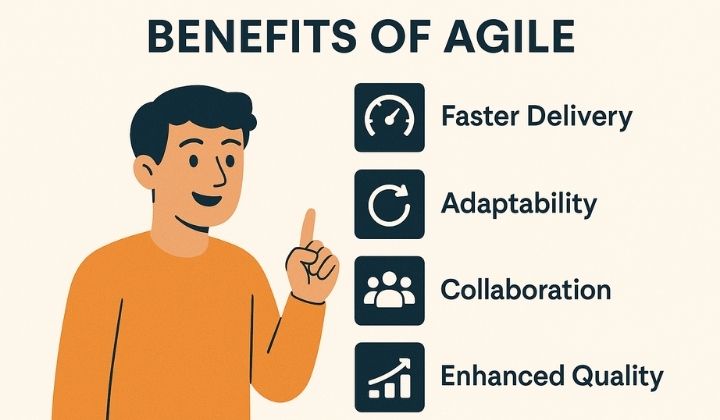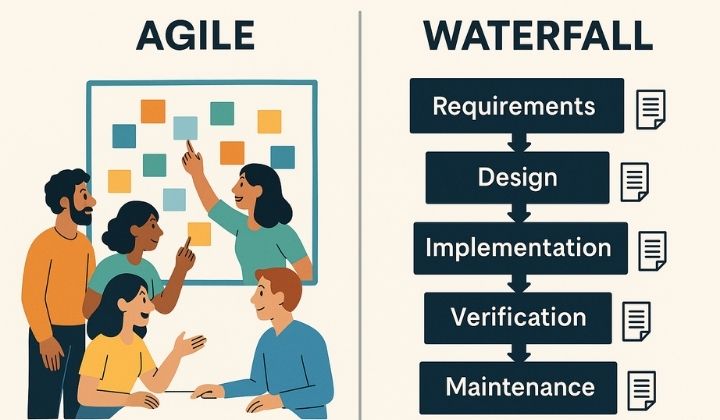
Choosing between Agile and Waterfall often feels like deciding between flexibility and structure in your project management approach. Each method offers distinct advantages depending on your project’s needs, team dynamics, and goals.
The key difference is that Agile embraces change through iterative development with constant feedback, while Waterfall follows a sequential process where each phase must be completed before moving to the next.

When planning your next project, understanding these methodologies can save you time and resources. Agile works brilliantly for projects needing adaptability and continuous improvement.
This makes Agile popular for software development, where requirements might evolve. Waterfall, with its structured approach and comprehensive documentation, suits projects with clear, unchanging requirements.
Many successful organisations don’t stick to just one methodology. They often combine elements from both approaches to create hybrid models that use the strengths of each method.

Agile is an iterative approach to project management that emphasises flexibility and continuous improvement. Teams deliver value to customers quickly by prioritising collaboration, adaptability, and customer feedback.
Agile project management is built on four core values from the Agile Manifesto: individuals and interactions over processes and tools, working software over comprehensive documentation, customer collaboration over contract negotiation, and responding to change over following a plan.
These values are supported by twelve principles focusing on customer satisfaction, embracing change, and frequent delivery of working products. Agile welcomes changing requirements, even late in development.
This flexibility lets teams adapt quickly to new information or customer needs. Agile teams work closely together, with daily communication and face-to-face conversations being the most efficient way to share information.
Several frameworks fall under the Agile umbrella. Each has unique approaches but shares the same foundational principles:
You can tailor these methodologies to your project needs or combine them for a hybrid approach.
The Agile workflow is cyclical, not linear. This allows for continuous improvement through short feedback loops.
A typical Agile cycle includes:
Teams move work items through these stages repeatedly, responding adaptively to changes throughout the process.
Agile puts a strong emphasis on delivering working features early and often. This incremental approach helps you see progress quickly and make adjustments based on real feedback.

Waterfall is a sequential, linear approach to project management. Each phase must be completed before the next begins.
This structured framework offers clear documentation, defined deliverables, and predictable timelines. Waterfall is particularly suitable for projects with well-defined requirements and minimal expected changes.
The Waterfall model follows a strict sequential flow, moving steadily downwards through phases like a waterfall. Waterfall requires complete documentation and planning before development begins.
Key principles include:
Waterfall assumes that requirements can be fully understood upfront and won’t change much during development. This makes it ideal for projects where requirements are stable and well-documented, such as construction or manufacturing.
Waterfall usually includes five to seven distinct phases in a linear sequence. Each phase must be finished before the next can begin.
Each phase produces specific deliverables that become inputs for the next phase. For example, the requirements document guides system design.
This structured approach provides clear visibility into project progress and helps maintain focus on deliverables.
Waterfall project management relies on comprehensive upfront planning and clear documentation. You’ll find this approach useful when your project needs strict regulatory compliance or has fixed budgets and timelines.
Waterfall PM Characteristics:
The Waterfall methodology works well for projects with stable requirements and predictable outcomes. Project managers focus on careful planning, resource allocation, and maintaining strict phase boundaries.
Budget tracking in Waterfall is straightforward since you estimate costs during the planning phase. This predictability makes it easier to manage stakeholder expectations and report progress against milestones.
The Agile and Waterfall methodologies represent very different approaches to project management. These differences affect how teams plan, adapt to changes, and deliver results.
Waterfall follows a sequential, linear approach where each phase must be completed before moving to the next. This method relies on thorough upfront planning and clear documentation before development starts.
Agile uses an iterative approach, with development occurring in short cycles called sprints. Cross-functional teams collaborate closely throughout the project lifecycle.
Waterfall creates clear boundaries between project phases:
Agile blurs these boundaries by addressing all aspects continuously. Agile prioritises working software over comprehensive documentation, while Waterfall requires detailed documentation at each stage.
The core philosophy is different: Waterfall assumes requirements won’t change much, while Agile expects and welcomes change throughout development.
With Waterfall, you create detailed project plans upfront. The team maps out the entire project timeline, resource allocation, and deliverables before development starts.
Requirements must be clearly defined at the start, with little room for major changes later. This approach works well when project requirements are stable and understood.
Agile planning happens continuously. You create a product backlog of features, prioritising items based on value.
Planning occurs at multiple levels:
Execution in Agile involves regular feedback through sprint reviews and retrospectives. Teams refine requirements and adjust priorities based on stakeholder input and changing conditions.
Waterfall execution follows the predetermined plan with formal approval processes between phases. This makes it more structured but less adaptable.
Agile shines in environments where requirements evolve or aren’t fully known at the start. You can incorporate changes at any point in the development process.
The sprint-based approach lets you reprioritise work regularly. Teams can add new features to the backlog or modify existing ones based on feedback and business needs.
Waterfall offers limited flexibility once development begins. Changes to requirements after the initial phase usually need formal change requests, impact analyses, and often result in timeline and budget adjustments.
This rigid structure makes Waterfall less suitable for projects with uncertain requirements, but more predictable for well-defined ones.
Testing happens throughout Agile development, so teams can identify issues early. In Waterfall, most testing happens after implementation, making late-stage problems more costly to fix.
Waterfall provides a single final delivery at project completion. You’ll have a clear timeline with specific milestones and a fixed end date set early in the project.
This approach offers predictability but delays value delivery until the project is finished, which could take months or years.
Agile delivers value incrementally through regular releases. You get working software after each sprint, usually every 2-4 weeks.
This allows for early market testing, faster return on investment, and the option to stop the project early if needed.
Agile addresses common lifecycle phases continuously, while Waterfall does them one after the other.
Time-to-market is generally faster with Agile due to incremental delivery. Waterfall may provide more comprehensive solutions at completion, but with longer waiting periods.
Agile methodology offers significant benefits in today’s fast-paced development environment. Its flexible framework lets teams adapt quickly to changing requirements and stay aligned with customer needs.
Agile puts ongoing communication with customers at the centre of the development process. Unlike Waterfall, which gathers requirements only at the start, Agile encourages continuous customer involvement.
This means you receive regular feedback on working features. Your product meets actual user needs, not just perceived ones.
You can incorporate changes in market conditions or user preferences quickly. Customers review and test functional components before the whole project is complete.
This reduces the risk of delivering a product that misses the mark or needs lots of rework. Customer involvement also helps prioritise features, so you focus on what matters most to users.
Agile frameworks focus on iterative development with regular reflection periods. Each sprint or iteration gives teams a chance to evaluate progress and refine how they work.
Key aspects include:
Teams can quickly spot and fix bottlenecks or problems. This approach helps teams improve efficiency over time, as they learn and adapt.
Continuous improvement isn’t just about processes. Each iteration builds on the previous one, letting teams refine the product as requirements change.
The Waterfall methodology offers several benefits, making it a strong choice for certain projects. Its linear approach brings structure and clarity.
Waterfall provides a clear, step-by-step framework that moves from one phase to the next. This linear progression gives teams a predictable roadmap.
Each phase has specific deliverables and a review process. With clear milestones, tracking progress becomes easier.
This method suits projects with well-defined requirements that are unlikely to change. It works well for large, complex projects where everyone understands the scope from the start.
Key benefits of Waterfall’s structure:
Waterfall places strong emphasis on thorough documentation throughout the project. This traditional approach requires detailed plans before development starts.
You’ll create comprehensive specifications in the early phases. This documentation helps keep everyone aligned and reduces misunderstandings.
Good documentation is especially useful if team members change or you revisit the project later. It provides a clear record of decisions, requirements, and designs.
Documentation advantages:
Agile offers many benefits, but it also brings challenges. These can affect project scope, team dynamics, and long-term planning.
Agile methods like Scrum work best for small, co-located teams. As your organisation grows, coordinating multiple Agile teams becomes more complex.
Daily stand-ups and frequent meetings help small teams, but can become time-consuming in large organisations. Decision-making may slow down as more people get involved.
Allocating resources across several teams working on connected components gets harder. This often leads to dependencies that are tough to manage in Agile.
Some organisations use hybrid or scaled Agile frameworks (like SAFe or LeSS) to tackle these issues. However, these add complexity and can drift from pure Agile principles.
Agile values working software over comprehensive documentation, which creates challenges for knowledge transfer and compliance. When priorities shift, keeping documentation up to date can be tough.
New team members often struggle to get up to speed without detailed documents. This slows onboarding and can create knowledge gaps.
For regulated industries like healthcare or finance, Agile’s lighter documentation may not meet compliance standards. Balancing agility with audit trails becomes important.
When team members leave, they may take important knowledge with them if it isn’t documented. This risk is higher in Agile environments where teams rely on shared understanding.
The Waterfall methodology has clear constraints that can affect project outcomes. These issues often come from its rigid, step-by-step structure.
Waterfall needs each phase finished before moving to the next. This rigid approach means you can’t easily return to previous stages without disruption.
If requirements are misunderstood at the start, you might only spot problems during testing or implementation. Fixing issues this late is costly and time-consuming.
Waterfall’s focus on documentation also adds overhead. You need to create extensive documents before development, which can delay progress.
Client feedback usually comes after development finishes. This means you might build something that doesn’t match client expectations, even if you followed the original plans.
Waterfall struggles with changing requirements, which is a problem in today’s fast-paced environment. New market needs can appear during development, but Waterfall makes it hard to adapt.
If changes are requested mid-project, you have to either ignore them until the next cycle or restart the process. Both options are inefficient.
The model assumes you can define all requirements upfront, but this is rarely true for complex projects. As work progresses, stakeholders often realise what they really need, leading to changes Waterfall can’t easily handle.
This lack of flexibility can mean you deliver products that meet original specs but no longer fit the business needs.
Choosing between Agile and Waterfall means looking closely at your project’s needs, your team’s strengths, and your industry. Your choice affects your timeline, budget, team dynamics, and overall success.
Start by looking at how clear and stable your project requirements are. Waterfall works best for projects with well-defined, stable requirements where you can visualise the end product from the start.
If you know exactly what you need and expect few changes, Waterfall offers predictability. Choose Agile if requirements are likely to change or if you need regular client feedback.
Consider these factors:
Your team’s experience with each method matters. Teams used to traditional approaches may do better with Waterfall, while those familiar with iterative work excel in Agile.
Think about how your team communicates. Agile needs constant collaboration, daily stand-ups, and open sharing. Teams that thrive on autonomy and teamwork may prefer Agile.
Team size and location also play a role.
Remember to consider training and transition costs, especially if you’re switching to a new approach.
Different industries tend to favour certain methods. Healthcare and financial sectors often choose Waterfall due to regulations and documentation needs.
Software development and creative fields usually embrace Agile for its flexibility and focus on customer needs. Many modern projects now use hybrid approaches tailored to their needs.
Here are some industry patterns:
| Industry | Common Methodology | Key Reason |
|---|---|---|
| Construction | Waterfall | Sequential building processes |
| Software | Agile | Rapidly changing requirements |
| Healthcare | Waterfall/Hybrid | Regulatory compliance |
| Marketing | Agile | Responsive to market feedback |
Let your industry’s challenges, compliance needs, and market conditions guide your choice.
Organisations often need to shift between methodologies as projects evolve. Moving from one approach to another takes careful planning and a good understanding of both.
Hybrid approaches blend Agile and Waterfall to get the best of both. The “Water-Scrum-Fall” model, for example, uses Waterfall for planning and deployment, and Agile for development.
Many project management tools support both methods and hybrids, making the switch easier.
A phased transition is often smoother than a sudden change. You might start by adding Agile practices like daily stand-ups to your Waterfall projects.
Hybrid elements can include:
Switching between methodologies needs strong change management. Training is key—make sure your team understands the new approach before you roll it out.
Start with a pilot project instead of changing everything at once. This lets you spot challenges early.
Keep communication open during transitions. Explain:
Expect some resistance, especially when moving from Waterfall to Agile, which encourages self-organisation over strict hierarchies.
Use the right metrics to measure success. For Waterfall-to-Agile transitions, track things like team velocity and customer satisfaction, not just adherence to the original plan.
Project teams often wonder about methodology choices that affect timelines, flexibility, and results. Here are answers to common questions about the key differences.
Agile is an iterative process, while Waterfall follows a linear flow. In Waterfall, you must finish each phase before starting the next, with detailed documentation at every step.
Agile breaks work into small sprints, usually lasting two to four weeks. You can adjust requirements throughout the project as you get feedback after each sprint.
Waterfall requires detailed planning upfront and allows few changes once you start. Agile welcomes change and adapts as the project develops.
Waterfall projects usually have a hierarchical structure. A project manager oversees specialist roles that work one after the other.
Communication happens through formal channels. Teams document handoffs between each phase.
Agile uses cross-functional teams who share responsibility for delivering value. The team includes a Product Owner who prioritises requirements, a Scrum Master who removes obstacles, and Development Team members with overlapping skills.
In Agile, the customer stays involved throughout the project. In Waterfall, the client mainly interacts at the start during requirements gathering and at the end during delivery.
Agile offers flexibility and faster delivery of working features. Teams get continuous feedback from customers.
This helps spot problems early and adjust quickly to changes. However, Agile can lead to scope creep and needs more client involvement.
Budgeting is also harder in Agile because requirements often change.
Waterfall gives you a clear structure with predictable timelines and thorough documentation. It makes resource planning easier when requirements are stable and well-understood.
But Waterfall struggles to handle changes. Testing happens late, which can reveal big issues near the end.
Stakeholders also have to wait longer to see results.
Agile suits projects where requirements keep changing or when you need to deliver quickly. Software development, marketing campaigns, and research projects benefit from Agile’s adaptability.
Waterfall works best for projects with stable, well-defined requirements or strict regulations. Construction, manufacturing, and hardware development often use Waterfall’s structured approach.
Team experience also plays a role. New teams may find Waterfall easier to start with, while Agile needs a cultural shift towards self-organisation and continuous improvement.
Hybrid approaches let you use the strengths of both methods. You might use Waterfall for planning and architecture, then switch to Agile for development.
Some organisations use “Water-Scrum-Fall,” starting with Waterfall for requirements and planning, then using Agile for development cycles.
Clear communication helps everyone understand which method to use for each project phase. This makes it easier for teams to move smoothly between approaches.
Waterfall delivers the complete product at the end of the development cycle. This process can take months or even years.
You get comprehensive documentation with Waterfall. However, you only see value once the project finishes.
Agile produces working increments of the product on a regular basis. This means you can release features sooner and gather user feedback early.
You can use this feedback to shape future iterations. Agile allows you to respond to changes as they happen.
Waterfall offers predictability in timeline and budget. Agile gives stakeholders earlier access to working features and lets you reprioritise as business needs change.
See your entire business at a glance
Get a clear, all-in-one view of your entire business, so you can stay on top of everything that matters. Whether you're juggling multiple projects or just need a better way to stay organised, our platform gives you the visibility you need, fast.
Instant setup. No payment details needed.